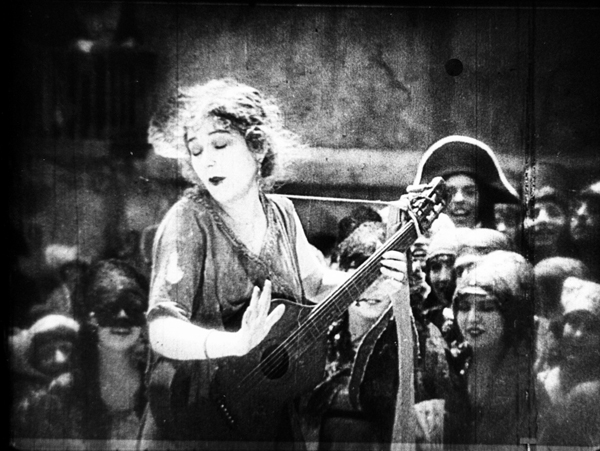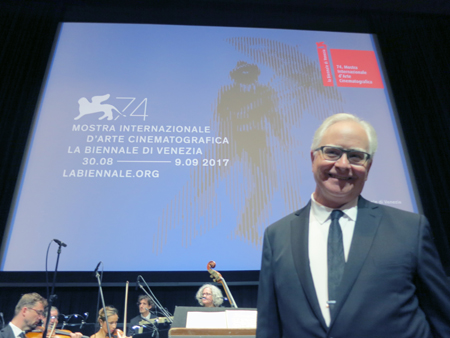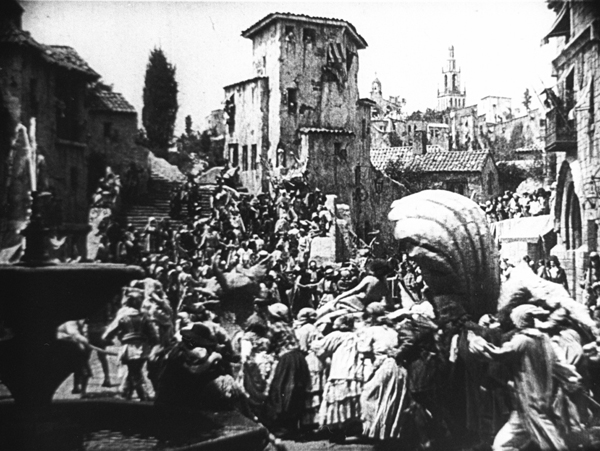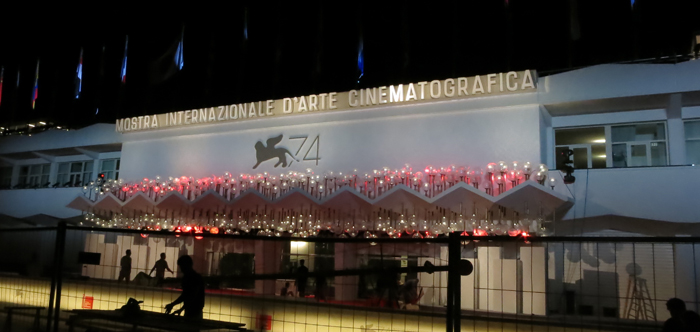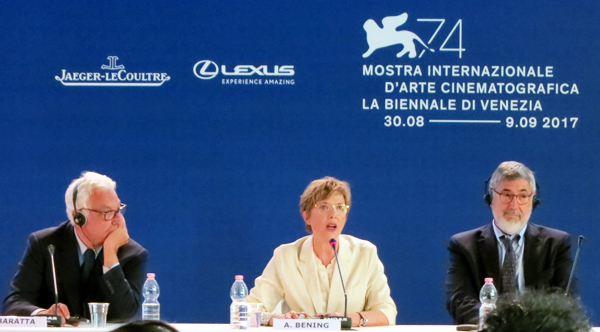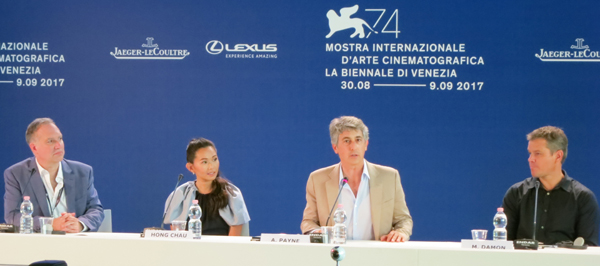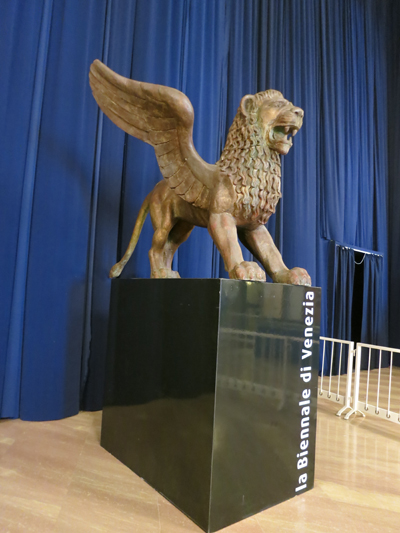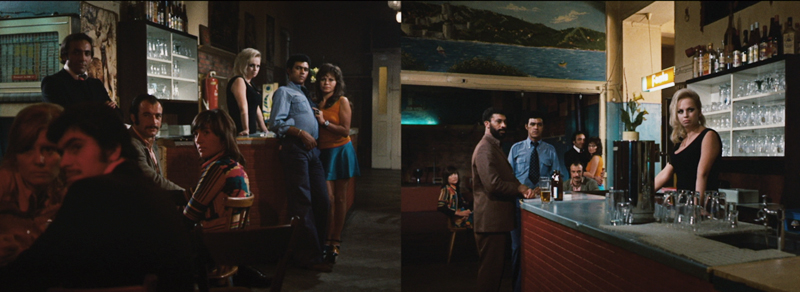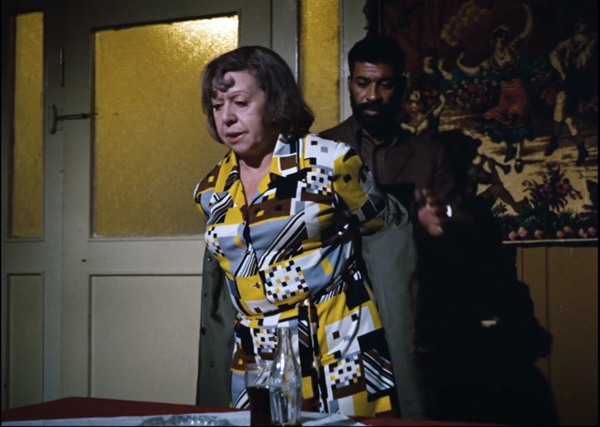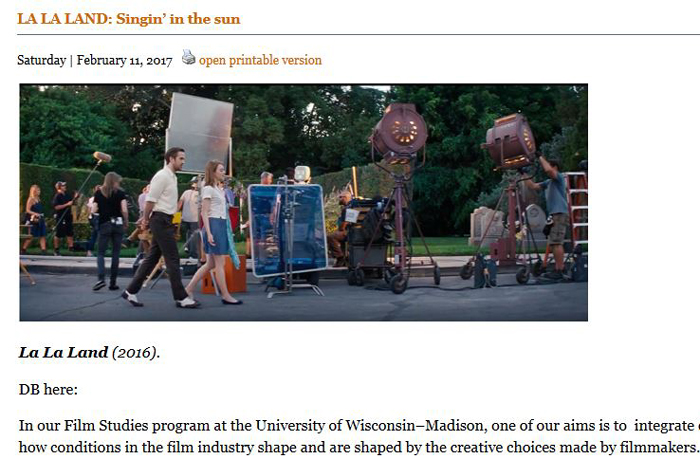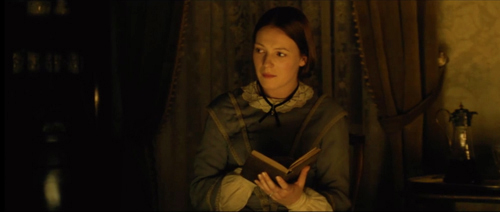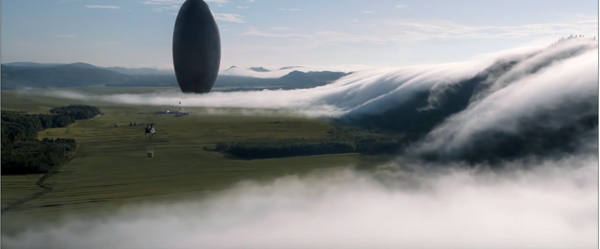Archive for 2017
Venice 2017: Lubitsch and Pickford, finally together again
Rosita (1923).
KT here:
Few of Ernst Lubitsch’s and Mary Pickford’s silent films are as little known to modern viewers as Rosita (1923). It survived only in an incomplete print in the Soviet film archive, and a few other archives had copies of that print. Specialist researchers could see it, as I did while working on Herr Lubitsch Goes to Hollywood. (You can get a downloadable copy here.) Now the Museum of Modern Art has made a 4K restoration that played here at the Venice International Film Festival as a special screening on the night before the festival opening. Curator Dave Kehr introduced the film.
Rosita has gained an unwarranted reputation as an inferior Lubitsch film. In Kevin Brownlow’s interview with Mary Pickford published in The Parade’s Gone By, Pickford claims that she was not happy with Rosita and parted ways with Lubitsch as a result. As I detail in Herr Lubitsch, however, correspondence between Pickford and Lubitsch reveals that a few years after Rosita, Pickford was still on cordial terms with him and asked for help on the editing of Sparrows. Why she made such a story up is anybody’s guess, but no one should see it for the first time believing that Pickford’s negative opinion, expressed late in her life, was her view of the film in the 1920s.
Rosita was Lutbitsch’s first American film, though as I show in my book, he had learned American style while still working in Berlin and that it shows in his last two German films, Das Weib des Pharao (1922) and Die Flamme (1923). Rosita is a neat blend of Lubitsch’s two favorite genres during his German period, comedy and historical epic.
The plot has Pickford as the title character, a Spanish street singer and dancer (see top) who catches the eye of a philandering king. Despite the actress’ reputation as a sweet young thing with sausage curls, she was quite versatile. Here she plays a street-wise, confident young woman clever enough to hold off the king’s advances while tricking him into lavishing her and her family with clothes and a villa.
There’s also a handsome soldier; Rosita falls in love with him and must save from the gallows. His plight furnishes the more serious and suspenseful side of the plot.
Lubitsch uses the big sets and crowds that he had become famous for with films like Madame Dubarry (1919) and Anna Boleyn (1921). Working with a Hollywood budget, he created some huge vistas, including a street scene near the beginning where carnival revelers are seen from the foreground to the very distant background (with a glass shot providing the towers; see bottom). The endlessly tall prison wall is another impressive setting.
The print we have seen up to now was not in good shape visually, being quite contrasty with blown-out highlights. The MOMA has done an impressive job of restoration, improving the visual quality distinctly. The intertitles in the surviving print, being in Russian, had to be replaced by using many sources. One reel preserved by Pickford herself provided the visual design template (still photos of scenes used as backgrounds for art titles). The texts were translated from Russian, gleaned from Swedish and German censorhip lists, an early draft of the screenplay held by the Academy of Motion Picture Arts and Sciences, a few lines quoted in reviews of the time, and a music cue sheet preserved at George Eastman House.
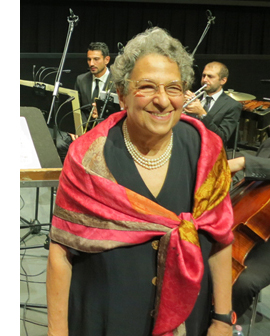 Gillian Anderson described to us the process of reconstructing the original score. It “was actually created from the 1923 cue sheet by James C. Bradford based on the original score by Louis F. Gottschalk. I located 45 of the pieces called for in the cue sheet (from collections all over the world, including the LC), timed each scene, cut each piece of music to fit each scene (the music was specified by the cue sheet). I only orchestrated one piece. Then I created the piano conductor score and then cut and pasted each of the orchestral parts. to match. The orchestrations for all but one of the pieces were the original orchestration from the teens and twenties.”
Gillian Anderson described to us the process of reconstructing the original score. It “was actually created from the 1923 cue sheet by James C. Bradford based on the original score by Louis F. Gottschalk. I located 45 of the pieces called for in the cue sheet (from collections all over the world, including the LC), timed each scene, cut each piece of music to fit each scene (the music was specified by the cue sheet). I only orchestrated one piece. Then I created the piano conductor score and then cut and pasted each of the orchestral parts. to match. The orchestrations for all but one of the pieces were the original orchestration from the teens and twenties.”
The result works beautifully with the film, as Anderson demonstrated when she conducted the Mitteleuropa Orchestra to accompany the presentation (right).
Rosita may not be among Lubitsch’s greatest films, but it is charming both in itself and as a display of Pickford’s talents. He would go on to discover the genres that made him one of Hollywood’s top directors. In place of the delightfully broad comedy of his German comedies like Ich möchte kein Mann sein (1918) and Die Puppe (1919) he discovered the sophisticated romantic comedy in such masterpieces as The Marriage Circle (1925) and Lady Windermere’s Fan (1926). It would serve him well in the sound era with Trouble in Paradise (1932), The Shop around the Corner (1940), and others. Earlier, as sound came in, he turned out a variant of the genre in a brief series of romantic musical comedies (e.g., The Love Parade, 1929; The Smiling Lieutenant, 1931).
The applause after the screening of Rosita was enthusiastic and prolonged. The restoration should receive wide circulation at festivals and archival series, as well as on Blu-ray–presumably with this score included.
Our Rosita images come from a print derived from the Russian version. The MoMA restoration is far more crisp and clear.
Thanks for Gillian for correcting our original brief description of her work on reconstructing the score and for providing a more detailed account of how she did it!
Rosita (1923).
Venice 2017: Early days
DB here:
After the triumph of Rosita (more on that to come), the first full day of the Biennale launched with several press screenings and press conferences. The opening conference featured Festival President Paolo Baratta (below), Director Alberto Barbera, and jury heads including Annette Bening (below), Benoît Jacquot, and John Landis (below).
During that session, two subjects recurred: Netflix and Virtual Reality. Some Netflix films are playing out of competition: Our Souls at Night, with Robert Redford and Jane Fonda (who will get honorary Golden Lion awards); and Netflix’s first Italian production, Suburra. In addition, the Mostra will show all the episodes of Errol Morris’s Netflix series Wormwood. Barbera remarked that festivals must follow where auteurs lead. Now that so many filmmakers are directing telefilms and series “with the same attitude” they employ in theatrical features, festival progamming must take notice.
 Similarly with VR. Baratta pointed out that this medium is now being used by artists, and Venice has a historical and aesthetic obligation to keep up with moving-image explorations. Barbera added that for him VR was not the future of movies; it’s a new medium that will exist alongside them. Just as film didn’t kill theatre and television didn’t kill film, VR is likely to flourish on its own. It will likely have its dedicated venues, such as MK2’s VR theatre in Paris and similar spots in Amsterdam.
Similarly with VR. Baratta pointed out that this medium is now being used by artists, and Venice has a historical and aesthetic obligation to keep up with moving-image explorations. Barbera added that for him VR was not the future of movies; it’s a new medium that will exist alongside them. Just as film didn’t kill theatre and television didn’t kill film, VR is likely to flourish on its own. It will likely have its dedicated venues, such as MK2’s VR theatre in Paris and similar spots in Amsterdam.
John Landis admitted that he was intrigued by VR and wanted to learn how to use it. Can it tell a full-length story? (Most VR pieces are short and situation-bound.) Can it focus the viewer’s attention—a key component of traditional visual narrative? Landis noticed that his experiences of VR gave the viewer great freedom of when and where to look. Could storytelling harness that freedom? It was good to see a filmmaker pondering these basic issues.
We saw the first screening of Alexander Payne’s Downsizing, a sharp and heartfelt satire on consumerism and ecology. Matt Damon and Kristen Wiig play a couple who decide to take advantage of a new technology that shrinks humans to 5-inch heights, and thus allows them to live more cheaply and reduce the strain on the planet.
The situation takes several unpredictable turns and in the face of impending disaster veers into a Capraesque optimism. Yet there’s a somberness here too, perhaps most akin to that in About Schmidt. Alexander mentioned Chekhov as an influence, and he admired the writer for realizing that emotional effects stand out against “a cold background.” The clinical scientific milieu of the downsizing operation and the arid cheerfulness of Leisureland, a sort of micro-EPCOT, provide that backdrop for the problems facing tiny Matt Damon.
In the press conference, Damon called Alexander’s direction meticulous and “sure-handed.” That shows in the film: No bouncy-camera grab-and-go, but precisely staged scenes. One sequence, that showing the medical mechanics of the downsizing process, is shot for shot as cogent and engaging a stretch of cinematic storytelling as I’ve seen in a long while. There’s also a good gag when Damon wakes up from the surgery and immediately…well, I can’t spoil it. Below, here are Jim Taylor, co-screenwriter; actor Hong Chau, who plays a Vietnames dissident; Payne; and Damon.
Our old friend Mark Johnson produced the film. It was encouraging to see the huge press turnout and the excellent reviews (Variety Hollywood Reporter, The Wrap) that Downsizing got. It goes immediately to Toronto.
Thanks to Peter Cowie, Alberto Barbera, Michela Lazzarin, and all of their colleagues for inviting and assisting us.
We have a blog entry devoted to Alexander Payne here, where he mentions his and Jim’s long-germinating plans for Downsizing. Kristin compares his work to Chekhov there too.
Fassbinder’s figures: Jeff Smith on ALI: FEAR EATS THE SOUL
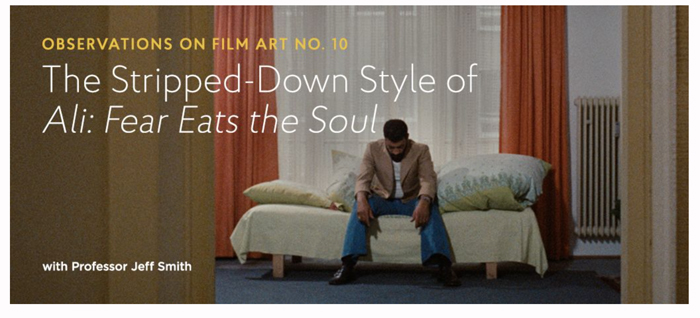
DB here:
Normally our co-conspirator Jeff Smith would be guest-blogging to fill in background on his new installment on the Criterion Channel. That entry is devoted to Fassbinder’s great social melodrama Ali: Fear Eats the Soul. But Jeff is ramping up for the start of a semester, and we’re hustling to get ready for a trip, so let this notice do duty.
In this month’s entry, Jeff digs deep into Fassbinder’s directorial style and shows how it connects to the film’s portrayal of bigotry–ethnic, racial, age-related. Since at least Katzelmacher (1969), and right up to Querelle (1982), Fassbinder was constantly experimenting with performance and staging. Ali is one of his triumphs. Jeff is especially acute, I think, in showing how before-and-after parallels in the drama emerge from shrewd repetitions of compositions and mise-en-scene. Thanks to the boffins at Criterion, these become crystal-clear through judicious split-screen.
Jeff’s entry is one of our very best, and we hope subscribers to FilmStruck and the Criterion Channel will enjoy it. The transfer is very pretty too. Coming up in future months: entries on M, The Phantom Carriage, Brute Force, and Chungking Express.
As for Kristin and me, we’re off to the Venice International Film Festival. Peter Cowie has kindly invited me to be on the panel devoted to discussing the projects in the Biennale College Cinema 2017. From the press release:
“The thirteen feature films already produced and screened during the first four years of the Biennale College Cinema program have met with acclaim throughout the world. Produced on an ultra-modest budget, each of them showed an unusual talent and an innate gift for filmmaking,” notes moderator Peter Cowie (film historian and former Int’l Publishing Director of Variety). “The Biennale College Cinema scheme is exciting chiefly because it is in essence a workshop – a workshop and laboratory that places the focus squarely on two essential themes: the making of low-budget films in a period of global recession, and the need to find youthful auteurs if the cinema is to be reinvigorated.” The laboratory was created by the Biennale di Venezia in 2012 and is open to young filmmakers from all over the world.
This is very exciting. And while we’re in Venice, we hope to reconnect to old friend Mark Johnson (producer of innumerable outstanding films, including Rain Man, Logan Lucky, and Galaxy Quest) and newer friend Alexander Payne. They’re arriving with Downsizing. Many other major films will be there, and we hope to report on some of them here over the next two weeks. And then there’s some scary Virtual Reality….
Thanks as ever to Peter Becker, Kim Hendrickson, Grant Delin, and all their teammates at Criterion. A complete list of the Observations on Film Art series (ten already!) is here.
Videos of earlier Biennale College Cinema panels can be found here. Glenn Kenny discusses last year’s event on RogerEbert.com.
Our own efforts at split-screen analysis yielded a comparison of the murder and its replay in Mildred Pierce. You can see that here, and the accompanying blog entry here.
Ali: Fear Eats the Soul.
Is there a blog in this class? 2017
Kristin here–
As each fall semester looms, we provide you with a rundown of entries on our blog that might be useful to teachers and students. They also can be handy for other readers who want to check whether they have missed some entries that might interest them.
We started this blog nearly eleven years ago partly with the idea of providing supplementary material that might be of use to teachers who assign our Film Art: An Introduction textbook. But we don’t make any attempt to tie our entries to the textbook. Each year, however, we naturally deal with film techniques, formal strategies, stylistic choices, norms and transformations of them, and genre conventions, and some of these could be useful in teaching or preparing lectures for specific chapters of Film Art.
We haven’t listed every post, but you can find more by using the very efficient search engine or the many categories listed on the right-hand side. You can also see previous entries in this series here: 2007, 2008, 2009, 2010, 2011, 2012, 2013, 2014, 2015, and 2016.
Multiple chapters
“DUNKIRK Part 1: Straight to the good stuff” and “DUNKIRK Part 2: The art film as event movie.” These two entries discuss aspects of Christopher Nolan’s film. The first talks about Dunkirk’s minimal exposition, which would be relevant to Chapter 3 (Narrative Form), and the color scheme, which would relate to chapters 4 and 5, on Mise-en-Scene and Cinematography. The second part deals with its genre, as a mixture of the war film and thriller (Chapter 9); it also looks at the film’s temporal scrambling, which relates to Chapters 3 and 6 (Editing).
Chapter 3 Narrative Form
“Replay it again, Clint: Sully and the simulations” considers some ways of creating complex story-plot relationships, particularly through flashbacks that replayt events. It concentrates on recent Clint Eastwood films and especially Sully.
In “ARRIVAL: When is now?” David looks at that rare phenomenon, the flashforward. He concentrates on Denis Villeneuve’s science-fiction film and its challenges to the viewer.
We have a sneaking suspicion that many teachers will be teaching La La Land. It would work as an accompaniment to several of our chapters in Film Art (narrative, sound, genre, etc.). We’ve blogged about it three times this year. In “How LA LA LAND is made,” we analyze the narrative structure and how the songs fit into it (as well as following the classic template of the Broadway musical).
“Fantasy, flashbacks, and what-ifs: 2016 pays off the past” offers a study of depth of narration, particularly in films where our knowledge of the action is largely restricted to that of a single character’s. In some cases there is presentation of the character’s subjective thoughts and memories. Lots of recent films furnish examples.
“Anybody but Griffith.” This post also deals with staging, but specifically with a type of staging, often quite elaborate, that was used largely in the period from 1908 to 1920. It depended on sustained takes rather than editing and on the actors’ precise gestures and shiftings of position. David has written quite a lot about it as the “tableau” style. Useful for advanced students or if you’re teaching or studying silent cinema.
Chapter 4 The Shot: Mise-en-scene
“My girl Friday, and his, and yours” is about His Girl Friday. The first section examines the historical sources of the title phrase, while the second part deals at some length with subtleties of staging, both in depth and across the frame.
Chapter 5 The Shot: Cinematography
“Wisconsin Film Festival: Sometimes a camera movement …” offers a close study of a single long-take 360-degree panning movement in Terence Davies’ A Quiet Passion.
Chapter 6 The Relation of Shot to Shot: Editing
“Action and essence: Kurosawa’s SANSHIRO SUGATA on the Criterion Channel” examines the “axial cut.” It’s an editing technique that cuts closer and closer to (or, rarely, further away from) its subject straight along the axis of the lens, without a change of angle. It may sound obscure, but it’s actually commoner than you might think. Even The Simpsons uses it occasionally.
“Wisconsin Film Festival: Cutting to the chase, and away from it” examines crosscutting in some recent films.
“Camera connections: RED on FilmStruck: A guest post by Jeff Smith” looks at cinematographic style in Krszystof Kieslowski’s Three Colors: Red.
Chapter 7 Sound in the Cinema
“Spies face the music: Jeff Smith on FOREIGN CORRESPONDENT” analyzes how the musical score of Hitchcock’s film fits into the film’s narrative progression.
“Oscar’s Siren song 3: a guest post by Jeff Smith” examines the wide variety of approaches used in the musical scores of the 2016 Oscar nominees for best score.
Chapter 8 Summary: Style and Film Form
“Going inside by staying outside: L’AVVENTURA on the Criterion Channel” examines stylistic changes in Michelangelo Antonioni’s films, particularly relating to staging.
Chapter 9 Film Genres
“LA LA LAND: singin’ in the sun” has three guest experts on musicals discussing the conventions and innovations of La La Land.
For those who teach film noir (and quite a few of you do) might want to look at “Film noir, a hundred years ago.” It gives numerous examples of “film noir” lighting in films of the 1910s. This could also be used for low-key lighting in Chapter 4.
“Thrill me!” discusses the recent prevalence of the thriller movie, even among art-cinema directors.
“MONSIEUR VERDOUX: lethal lothario” treats Chaplin’s film as belonging to the serial-killer genre.
Chapter 12 Historical Changes in Film Art: Conventions and Choices, Tradition and Trends
“Murnau before NOSFERATU” could be useful in teaching the silent-German section of this chapter or if you show any early Murnau film. There’s nothing on Expressionism but quite a few examples from major German films of the late 1910s and early 1920s, primarily the restored Der Gang in der Nacht (1921).
“The ten best films of … 1926” is the latest in our annual attempt to call attention to the classics of the silent era, both famous and obscure. This year’s list covers several countries’ films, including Japan for the first time.
Miscellaneous
If you supervise dissertations or are writing a book yourself, you might be interested in seeing how David went about researching his forthcoming book, Reinventing Hollywood. Complete with exciting photos of boxes of file folders. See his “Oof! Out!”
Every now and then we post a wrap-up of recent DVDs and Blu-rays. “Silents nights: Stocking-stuffers for those long winter evenings, the sequel” concentrates on two releases, one a beautiful restoration of a well-known classic and one a rediscovery of a Native-American feature.
“OBSERVATIONS goes all FILMSTRUCK.” For those of you using the rich foreign and indie offerings of streaming service FilmStruck for teaching, class preparation, or personal pleasure, we have an introduction to our contribution to the supplements thereon. Our series of introductions to films, “Observations on Film Art” is, as its name suggests, a sort of extension of this blog. We do close analysis of a specific topic in one or two films, complete with more clips than we could possibly use in our entries here.
Finally, if readers, teachers, and students are curious about how Film Art came to be written, that comes up in our SCMS interview with Charlie Keil, linked in this blog entry.
Arrival












